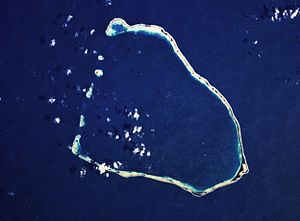Nukumanu Islands
| Nukumanu | ||
|---|---|---|
| NASA image of Nukumanu | ||
| Waters | Pacific Ocean | |
| Geographical location | 4 ° 32 ' S , 159 ° 24' E | |
|
|
||
| Number of islands | over 20 | |
| Main island | Amotu Island | |
| length | 22.5 km | |
| width | 16.1 km | |
| Land area | 2.5 km² | |
| total area | 282 km² | |
| Residents | 500 | |
| Nukumanu in the very northeast of the state of Papua New Guinea | ||
The Nukumanu Islands (formerly also "Tasman Islands") are an atoll in the Pacific Ocean north of Ontong Java . They belong to Papua New Guinea and are politically part of Melanesia . Culturally, it is one of the atoll due to the polynesischstämmigen population of the enclaves of Polynesia , which outside the Polynesian triangle are. Administratively it belongs to the Atolls Local Level Government of the North Bougainville District in the province of Bougainville .
geography
The atoll contains the easternmost land mass of the state of Papua New Guinea. The closest landmass is the Ontong Java atoll belonging to the state of Solomon Islands , 47 km further south. The closest landmass in the state of Papua New Guinea is the 253 km Takuu Atoll .
The islands are the result of the growth of a large coral reef . A ring of more than 25 islands ( motus ) surrounds a wide lagoon . The islands are very flat and only rise a few meters above sea level. The total area of the atoll is 282 km², while the land area of all islands together is only around 2.5 km².
Islands
The individual islands (archipelagos) in clockwise order, starting in the north:
|
east
|
south
|
west
|
The island by far the largest in terms of area and also the easternmost island is Nukumanu (Vaihale) Island . The main island and southernmost island is Amotu Island , where the largest village of the atoll, Amotu, is also located.
population
The atoll has a population of around 500. The village of Amotu is located on the southernmost island of the atoll of the same name. Nukumanu is one of the Polynesian exclaves . The people of the islands therefore live according to Polynesian traditions and speak a dialect of Polynesian belonging to the Samoan branch of the Polynesian languages . The islands' food supplies are poor. The inhabitants feed on fishing and simple forms of farming. Coconut palms and banana trees provide an important basis for nutrition .
economy
The Nukumanians are fishermen and divers . To a small extent, the inhabitants trade in seafood and pearl mussels, from which mother-of-pearl is extracted. Most of these are exported to Asia . This trade is the backbone of the Nucuman economy.
history
The crew of the German warship SMS Alexandrine hoisted the German flag on the Tasman Islands in October 1886 as a symbol of the occupation by the German Empire . After the German-British agreement of November 14, 1899 ( Samoa Agreement ), Nukumanu actually became part of the territory ceded to Great Britain, but remained part of the German colony due to an intervention by Governor Rudolf von Bennigsen and after formal renunciation by the Western Pacific High Commission New Guinea and only became part of the Australian mandate after the First World War through the Treaty of Versailles of 1919.
The atoll achieved sad fame in 1937: When flying over the famous American aviation pioneer Amelia Earhart and her navigator sent their last known position determination before their trail was lost in the vastness of the Pacific.
Culture
The traditional music of the Nukumanu Islands is related to the music of New Guinea with ceremonial dances accompanied by drums and choral singing. When drums are empty metal canister and bamboo tamping tubes (lopu) , to the other musical instruments include various wooden Idiophone (tamu) and a mouth bow (susupu) . During the 20th century, the guitar, ukulele and harmonica were introduced under European influence . In addition to special celebrations, regular gatherings where palm wine (kareve) was drunk provided an opportunity to make music. In a dance performance called hava , the women sit in the center surrounded by a circle of standing men who orient themselves towards the center. The performance begins with singing, which is replaced by the pounding rhythm that the women create with about 90 centimeter long bamboo tubes. Meanwhile, the men hit the ground with wooden poles that are supposed to represent spears. During their final dance, they let themselves fall several times on the floor in order to get up again together. This and other dances usually start slowly and accelerate the rhythm as the performance progresses. The traditional styles were still maintained at least until the mid-1980s, only Christian or national holidays were increasingly used as occasions.
Web links
Individual evidence
- ↑ [1]
- ↑ [2]
- ^ Richard Feinberg: Socio-Spatial Symbolism and the Logic of Rank on Two Polynesian Outliers. Ethnology, Vol. 27, No. 3 (Jul., 1988), pp. 291-310 , here p. 305
- ↑ [3]
- ^ Walter Nuhn: Kolonialpolitik und Marine , Bernard & Graefe, Bonn, 2002, p. 61
- ^ Hermann Joseph Hiery : The German administration of New Guinea 1884-1914. In the S. (Ed.): The German South Seas 1884-1914. A manual. 2nd edition. Schöningh, Paderborn u. a. 2003, pp. 277-311
- ↑ Jennifer Johnstone, Richard Feinberg: From "Oriori" to the Everly Brothers: Observations on the Music of Nukumanu. , In: The Journal of the Polynesian Society , Vol. 115, No. 4, December 2006, pp. 365–381, (PDF file; 590 kB)



